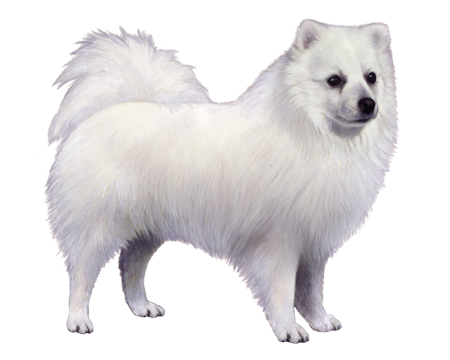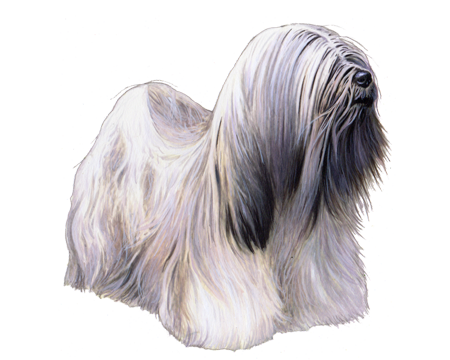
Lapponian Herder
The Lapponian Herder is an intelligent and affectionate working dog. Bred for herding (as their name suggests), these dogs make excellent high energy companions for active families.
Interested in discovering if your dog is a Lapponian Herder?
Check out Wisdom Panel's DNA tests.

Lapponian Herder Traits
General Appearance
Lapponian Herders are medium-sized, muscular (but not heavy) dogs with abundant energy and keen expressions.
Coat and Coloring
This double-coated breed has a fine, dense undercoat and an outercoat of medium-length or long, straight hair with an erect, harsh texture. Lapponian Herders have longer, more abundant hair on their necks, chests, and backsides of their thighs.
Lapponian Herders come in different shades of black, grey, and dark brown. They have lighter grey or brown markings on their heads, lower bodies, and legs. White markings on their necks, chests, and legs are permitted. Their undercoats are black, grey, or brown.
Distinctive Physical Traits
Lapponian Herders are muscular dogs that are slightly longer than tall with deep, long (but not broad) chests and tucked underlines. These dogs have straight, tapered muzzles and dark-colored, oval-shaped eyes that give them keen expressions.
heir medium-length, pricked ears are set rather far apart, and profuse hair covers the inside of their ears. Lapponian Herders have medium-length, low set tails profusely covered with hair. Their tails are held in a loose curve and may follow a circular motion when they are wagging.
Lapponian Herder Temperament
Words like docile, calm, intelligent, and energetic best describe Lapponian Herders. This breed is friendly, outgoing, willing to serve, and eager to spend time with family. Lapponian Herders are excellent companions but can be standoffish (though not aggressive) with strangers.
Lapponian Herders are hardworking, active dogs that require a lot of mental and physical stimulation. This breed is happiest when given a job to do. They are good with children and pets but, due to their strong herding instincts, they may attempt to herd them.
These dogs are known for being vocal and are especially prone to barking while working—a trait that may not endear them to the neighbors.


Lapponian Herder History
Lapponian Herders are an ancient Scandinavian breed. The Sámi people, an indigenous semi-nomadic tribe (also called Lapps or Laplanders), relied on Lapponian Herders to herd reindeer—earning them the nickname Reindeer Dogs.
Lapponian Herders are one of three Lapphund breeds. Some of the earliest references to these dogs, also known as the Lapinporokoira, date back to 1674. The population of Lapponian Herders plummeted when the Germans, forced out of Finland during World War II, burned down Lapland during their retreat. Dedicated breeders restored the breed in the late 1950s.
Once recognized as the same breed as the Finnish Lapphund, Lapponian Herders separated into their own breed—and gained acceptance into the Finnish Kennel Club—in 1966. In their native Finland, these dogs are still used to herd and guard reindeer, but their populations remain low.
Lapponian Herder Care
Nutrition
Feed Lapponian Herders a high-quality dog food that's appropriate for their life stage (e.g., puppy, adult, senior). Due to their high activity levels, Lapponian Herders tend to stay trim. However, it's still important to monitor their food intake. Using a standard measuring cup to portion out their food helps avoid overfeeding. Make sure treats account for no more than 10% of their daily calories.
Grooming
Lapponian Herders require regular brushing to remove dead hair and prevent matting. Like other double-coated breeds, weekly brushing is sufficient to maintain their coats. However, daily brushing is needed during "shedding season" in the spring and fall.
Clip their nails regularly to prevent them from becoming overgrown and causing pain or issues walking. Start a regular dental care routine that includes at-home teeth brushing when Lapponian Herders are puppies. This essential grooming task is important for good dental hygiene and lifelong health.
Exercise
Lapponian Herders need a job to do. This active breed likes to be on the go. They excel at sports such as competitive obedience, search and rescue, conformation, agility, rally, and dock diving. Any activities that take advantage of their strong work ethics, stamina, and eagerness to serve are good fits for this breed.
Lapponian Herders also make excellent companions for hiking, trail running, herding, and other outdoor activities. And they will happily engage in vigorous play sessions in their backyard or at the dog park. Without adequate exercise, these dogs are prone to becoming bored and destructive.
Mental stimulation is important, too. Offering puzzle toys or playing games like hide-and-seek will help tire out Lapponian Herders mentally and physically.
Training
Lapponian Herders are intelligent, obedient, and eager to learn new things. Focus on a positive, reward-based approach that uses praise, treats, and favorite toys to acknowledge good behavior. Start training when Lapponian Herders are puppies to channel their desire to please into positive behaviors. This early start helps ensure the dogs are well-trained into adulthood.
Lapponian Herders love being active, so use high-intensity training games to take advantage of their energy. Regular socialization can also help the breed become more comfortable around strangers.
Lapponian Herder Genetic Health Conditions
-
Canine Multifocal Retinopathy 3
Canine Multifocal Retinopathy 3 (CMR3) is an eye disorder that can cause retinal decay which may impact vision, but very rarely results in blindness.
-
Progressive Retinal Atrophy (Discovered in the Lapponian Herder)
Progressive Retinal Atrophy (PRA) is an inherited disorder that results in degeneration of the light sensing retina at the back of the eye, leading to progressive vision loss and eventual blindness. The associated genetic variant has been identified in the Lapponian Herder.
Knowing if your Lapponian Herder is a carrier or at-risk for these conditions can help you and your veterinarian plan for your pup’s lifelong care. With Wisdom Panel™ Premium, you can get results for over 200 genetic health tests.
Breed Group
Companion
This group consists of dogs typically bred for the specific purpose of human companionship, and many are popular pets because of their gentle nature. They became more common as the concept and luxury of dogs as pets prevailed.
Resources
https://www.akc.org/dog-breeds/lapponian-herder/
http://www.fci.be/Nomenclature/Standards/284g05-en.pdf
https://lapinkoira.weebly.com/lapponian-herder.html
Reviewed July 26, 2020 by Cindy Elston, DVM, MPH



























_Color.png)










